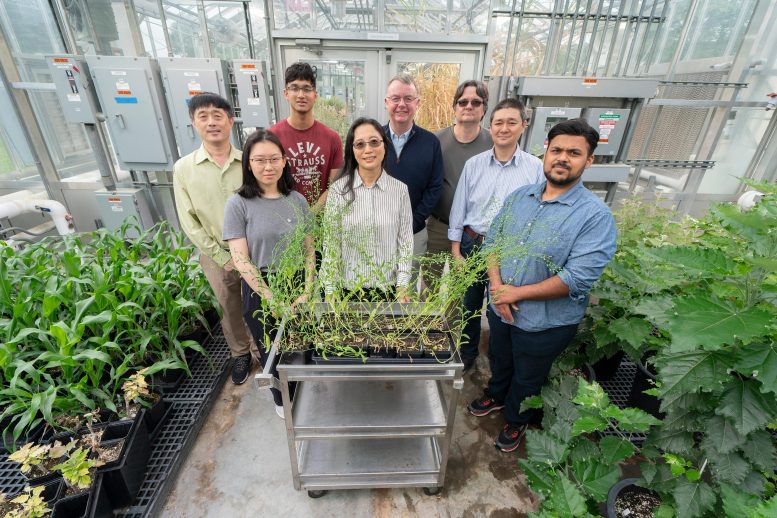
Artist’s representation of the effect of editing of all six copies of the TT8 gene in Camelina sativa. Seeds with inactivated TT8 genes (right) show yellow coloration, reduced thickness of their seed coat, and accumulation of nearly 22% more oil than wild type seeds (left). Credit: Valerie Lentz/Brookhaven National Laboratory
Scientists have increased oil production in Camelina sativa by 21.4% by gene-editing the TT8 gene, paving the way for more efficient biofuel crops.
As initiatives to reach net-zero carbon emissions from transportation fuels gain momentum, the need for oil derived from nonfood crops is on the rise. These crops harness sunlight to transform atmospheric carbon dioxide into oil, which is stored in their seeds. Crop breeders aiming to maximize oil production often favor plants with yellow seeds, as these typically yield more oil than brown-seeded varieties in oilseed crops like canola. This is due to a protein that colors the seeds brown, absent in yellow-seeded plants, which also plays a key role in oil production.
Breakthrough in Biofuel Crop Development
Now, plant biochemists at the U.S. Department of Energy’s (DOE) Brookhaven National Laboratory — who are interested in increasing plant oil synthesis for the sustainable production of biofuels and other bioproducts — have harnessed this knowledge to create a new high-yielding oilseed crop variety. In a paper just published in The Plant Biotechnology Journal,< they describe how they used tools of modern genetics to produce a yellow-seeded variety of Camelina sativa, a close relative of canola, that accumulates 21.4% more oil than ordinary camelina.
“If breeders can get a few percent increase in oil production, they regard it as significant, because even small increases in yield can lead to large increases in oil production when you’re planting millions of acres,” said Brookhaven Lab biochemist John Shanklin, chair of the Lab’s Biology Department and leader of its plant oil research program. “Our nearly 22% increase was unexpected and could potentially result in a dramatic increase in production,” he said.

The Brookhaven Lab research team (left to right): Jin Chai, Jodie Cui, Shreyas Prakash, Xiao-Hong Yu, John Shanklin, Jorg Schwender, Hai Shi, and Sanket Anaokar. All are members of Brookhaven Lab’s Biology Department; Prakash and Cui are undergraduate students at Cornell University and Stony Brook University, respectively, participating in the U.S. Department of Energy-sponsored Science Undergraduate Laboratory Internship program. Credit: Jessica Rotkiewicz/Brookhaven National Laboratory
Straightforward Idea, Unusual Plant
The idea behind developing this high-yielding strain of camelina was straightforward: mimic what happens in the naturally occurring high-yielding, yellow-seeded varieties of canola.
“Breeders had identified plants with more oil, some of which happened to have yellow seeds, and they didn’t really worry about the mechanism,” Shanklin said. But once scientists discovered the gene responsible for both the yellow seed color and increased oil content, they had a way to potentially increase oil yield in other species.
Gene-Editing for Enhanced Oil Production
The gene has the instructions for making a protein known as Transparent Testa 8 (TT8), which controls the production of compounds that give seeds their brown color, among other things. Importantly, TT8 also inhibits some of the genes involved in oil synthesis.
Xiao-Hong Yu, who led this project, hypothesized that getting rid of TT8 in camelina should release the inhibition on oil synthesis — and free up some carbon that can be channeled into oil production.
Getting rid of a single gene in camelina is very challenging because this plant is unusual among living things. Instead of having two sets of chromosomes — meaning two copies of each gene — it has six sets.
“This ‘hexaploid’ genome explains why there aren’t any naturally occurring yellow-seeded varieties of camelina,” Yu explained. “It would be highly unlikely for mutations to arise simultaneously in all six copies of TT8 to completely disrupt its function.”
Gene-Editing Strikes Oil
Thanks to the tools of modern genetics, the Brookhaven team had a way to knock out all six copies of TT8. They used gene-editing technology known as CRISPR/Cas9 to target the specific sequences of DNA within the TT8 genes. They used the technology to cleave the DNA at these locations and then create mutations that deactivated the genes. Yu and the team then performed a series of biochemical and genetic analyses to monitor the effects of their targeted gene editing.
“The yellow seed phenotype we were looking for was a great visual guide for our search,” Yu said. “This helped us find the seeds we were looking for by screening less than 100 plants — among which we identified three independently occurring lines in which all six genes were disrupted.”
The results: The seed coat color changed from brown to yellow only in plants in which all six copies of the TT8 gene were disrupted. The yellow seeds had lower levels of “flavonoid” compounds and “mucilage” — both normally produced by biochemical pathways controlled by TT8 — than brown seeds from strains of camelina with unedited genomes.
In addition, many genes involved in oil synthesis and the production of fatty acids, the building blocks of oil, were expressed at increased levels in seeds from the CRISPR/Cas9-edited plants. This resulted in the dramatic increase in oil accumulation. The altered seeds contained another positive surprise in that the levels of proteins and starch were unaltered.
The targeted mutations to TT8 were inherited in subsequent generations of the camelina plants, suggesting the improvements would be stable and long-lasting.
“Our results demonstrate the potential for creating new lines of camelina by gene editing, in this case by manipulating TT8 to enhance oil biosynthesis. Understanding further details of how TT8 and other factors control biochemical pathways may provide additional gene targets for increasing oil yields,” Shanklin said.
Reference: “Creating yellow seed Camelina sativa with enhanced oil accumulation by CRISPR-mediated disruption of Transparent Testa 8” by Yuanheng Cai, Yuanxue Liang, Hai Shi, Jodie Cui, Shreyas Prakash, Jianhui Zhang, Sanket Anaokar, Jin Chai, Jorg Schwender, Chaofu Lu, Xiao-Hong Yu and John Shanklin, 10 June 2024, Plant Biotechnology Journal.
DOI: 10.1111/pbi.14403
This research was funded by the DOE Office of Science — in part through a project known as “Enhancing Camelina Oilseed Production with Minimal Nitrogen Fertilization in Sustainable Cropping Systems” led by Montana State University; the Center for Advanced Bioenergy and Bioproducts Innovation (CABBI), a DOE-funded Bioenergy Research Center led by the University of Illinois Urbana-Champaign; and the Physical Biosciences program at Brookhaven Lab. Students supported by the Office of Science also contributed to this research. In addition, the scientists used a confocal microscope at the Center for Functional Nanomaterials (CFN), which operates as a DOE Office of Science user facility at Brookhaven Lab.









In a world that will soon be facing a mass starvation event, growing plants for fuel doesn’t seem to be the direction that science should be leading us to, see for example; https___www.globalresearch.ca_video-bill-gates-global-famine_5859705 (1).pdf